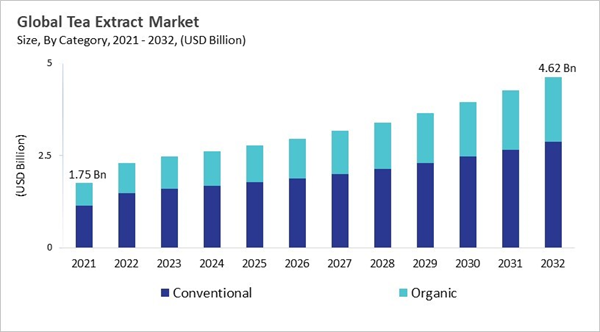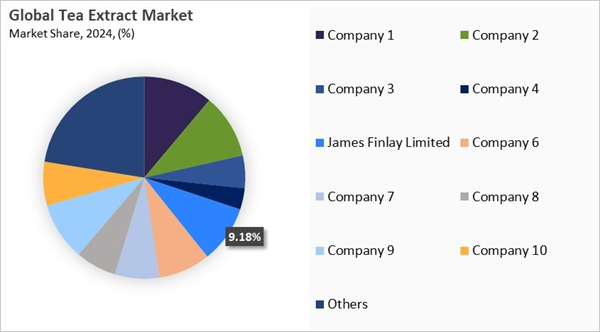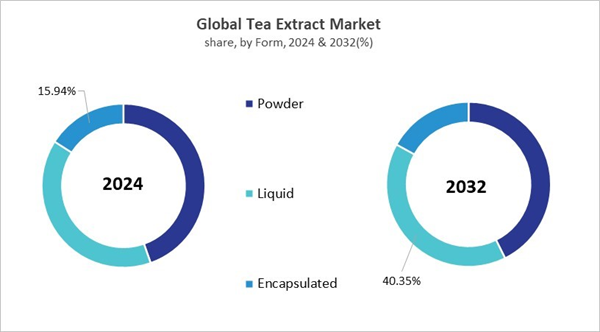Key Highlights:
- The Asia Pacific market dominated Global Tea Extract Market in 2024, accounting for a 41.26% revenue share in 2024.
- The China market is projected to maintain its leadership in Asia Pacific, reaching a market size of USD 578.49 million by 2032.
- Among the various Category, the Conventional segment dominated the global market, contributing a revenue share of 64.10% in 2024.
- In terms of Form, Powder segment are expected to lead the global market, with a projected revenue share of 42.68% by 2032.
- The Green Tea Extracts market emerged as the leading Type in 2024, capturing a 44.15% revenue share, and is projected to retain its dominance during the forecast period.
- The Food & Beverage Market in Application is poised to grow at the market in 2032 with a market size of USD 1.90 billion and is projected to maintain its dominant position throughout the forecast period.
- By Technology the Solvent Extraction Segment captured the market size of USD 1.40 billion in 2024 and this segment will maintain its position during the forecast period.
The tea extract market has evolved from conventional tea plantation into a large-scale industry that deals in beverages, nutraceuticals, cosmetics, and functional foods. Advancements in the extraction methods facilitated producers to separate tea’s bioactive compounds, producing concentrated and unique formats. Furthermore, growing recognition of health benefit like anti-inflammatory properties and antioxidants, with the government support and multinational funding, shifted tea extracts into premium good. The market has transformed toward traceability, sustainability, and Innovation in product formats, along with consumer demand for natural, functional ingredients, has led to widespread adoption in many fields.
Some important trends are a focus on health and wellness, a move into uses other than traditional tea drinks, and a push for organic farming and sustainability. To get into new markets, companies are coming up with new ways to deliver goods, putting money into research and development, and moving to new locations. Product innovation, supply chain integration, and mergers or acquisitions to reach more people are all part of competitive strategies. COVID-19, on the other hand, had a big effect on the market. It broke down supply chains, caused labor shortages, lowered demand in foodservice channels, and put a strain on companies' finances, which slowed down expansions and new product launches, which hurt market growth.
Driving and Restraining Factors
Drivers
- Rising Health And Wellness Trends
- Expansion Of Functional Foods And Beverages
- Growth Of Natural And Clean-Label Products
- Expanding Applications Across Industries
Restraints
- High Cost Of Production And Processing Challenges
- Stringent Regulatory Standards And Compliance Barriers
- Intense Market Competition And Substitutes
Opportunities
- Rising Popularity Of Plant-Based And Vegan Lifestyles
- Expansion Into Emerging Economies And Untapped Markets
- Innovations In Delivery Formats And Product Applications
Challenges
- Sustainability And Ethical Sourcing Of Raw Materials
- Maintaining Consistency And Quality Across Global Supply Chains
- Consumer Awareness And Education Gaps
COVID-19 Impact Analysis
The COVID-19 pandemic significantly disrupted the global tea extract market by impairing supply chains, restricting the movement of goods, and causing border closures, which led to delays in raw material sourcing. Key end-use sectors, including foodservice, cafés, and restaurants, experienced prolonged closures, resulting in a sharp decline in demand, especially for premium and specialty tea extract products. Labor shortages due to health concerns and social distancing further constrained tea harvesting and processing capacities, reducing overall production. Additionally, increased operational costs related to safety protocols and logistics, coupled with declining revenues, pressured profit margins and forced many companies to defer investments and product launches, ultimately impeding market growth. Thus, the COVID-19 pandemic had negative impact on the market.Market Share Analysis
The leading players in the market are competing with diverse innovative offerings to remain competitive in the market. The above illustration shows the percentage of revenue shared by some of the leading companies in the market. The leading players of the market are adopting various strategies in order to cater demand coming from the different industries. The key developmental strategies in the market are Acquisitions, and Partnerships & Collaborations.
Category Outlook
Based on Category, the market is segmented into Conventional and Organic. The organic segment attained 36% revenue share in the tea extract market in 2024. This segment is driven by growing consumer awareness of health, wellness, and sustainable sourcing practices. Organic tea extracts are often favored by health-conscious individuals who seek products free from synthetic chemicals and pesticides. The rising demand for clean-label and environmentally friendly products has given this segment significant momentum, with increasing applications in premium beverages, dietary supplements, and natural health products.Form Outlook
Based on Form, the market is segmented into Powder, Liquid, and Encapsulated. The liquid segment recorded 39% revenue share in the tea extract market in 2024. This type is valued for its quick solubility and effectiveness in providing a rich, authentic tea flavor. It is extensively used in ready-to-drink beverages, syrups, and other liquid-based applications. The liquid form appeals to industries seeking a faster production process and a product that closely replicates the natural tea experience, thereby making it a strong choice for premium and on-the-go beverage categories. Its adaptability to modern beverage trends makes it a crucial contributor to market growth.Type Outlook
Based on Type, the market is segmented into Green Tea Extracts, Black Tea Extracts, Oolong Tea Extracts, and Other Type. The black tea extracts segment recorded 31% revenue share in the tea extract market in 2024. Another key segment is black tea extracts, which are known for their robust flavor and widespread use in traditional tea beverages as well as in processed food products. Black tea extracts are commonly applied in ready-to-drink teas, bakery items, confectionery, and flavoring solutions due to their distinct taste profile. Their cultural popularity and established consumer base have enabled them to maintain consistent demand.Regional Outlook
Region-wise, the tea extract market is analyzed across North America, Europe, Asia Pacific, and LAMEA. The Asia Pacific segment gained 41% revenue share in the tea extract market in 2024. The tea extract market is growing in North America as more and more people want functional drinks, dietary supplements, and clean-label foods that are good for their health. The US is the leader in the region, with more and more uses for ready-to-drink teas, sports nutrition, and cosmetics with antioxidants. Europe has a long history of drinking tea, and this has led to a focus on organic, sustainable, and traceable sourcing, which has increased demand for nutraceuticals and personal care products. Germany, the UK, and France are at the top of the list. These countries have strict rules and a strong preference among consumers for natural products, which helps the market grow steadily.Asia-Pacific is the biggest market for tea extracts because China, India, and Japan are all major producers. At the same time, demand for instant powders, nutraceuticals, and functional blends is growing in the region. Rapid urbanization and rising health awareness are still driving innovation and the variety of products in the region. The market is still new in LAMEA, except for Mexico, but it has a lot of potential, especially in the Middle East and Africa where natural and herbal products are becoming more popular. Latin American countries outside of Mexico are slowly starting to use tea extracts in foods and drinks that are good for your health. This makes the region a good place for growth.
List of Key Companies Profiled
- Synthite Industries Ltd.
- MartinBauer
- Kemin Industries, Inc.
- Tata Consumer Products Limited (Tata Group)
- James Finlay Limited
- Archer Daniels Midland Company
- AVT Natural Products Ltd
- Indena S.p.A.
- Taiyo International (Taiyo Kagaku Corporation)
- Dohler GmbH
Market Report Segmentation
By Category
- Conventional
- Organic
By Form
- Powder
- Liquid
- Encapsulated
By Type
- Green Tea Extracts
- Black Tea Extracts
- Oolong Tea Extracts
- Other Type
By Application
- Food & Beverage
- Pharmaceuticals & Dietary Supplements
- Cosmetics & Personal Care
- Other Applications
By Technology
- Solvent Extraction
- Supercritical Fluid Extraction
- Ultrasound-Assisted Extraction
- Other Technology
By Geography
- North America
- US
- Canada
- Mexico
- Rest of North America
- Europe
- Germany
- UK
- France
- Russia
- Spain
- Italy
- Rest of Europe
- Asia Pacific
- China
- Japan
- India
- South Korea
- Singapore
- Malaysia
- Rest of Asia Pacific
- LAMEA
- Brazil
- Argentina
- UAE
- Saudi Arabia
- South Africa
- Nigeria
- Rest of LAMEA
Table of Contents
Companies Mentioned
- Synthite Industries Ltd.
- MartinBauer
- Kemin Industries, Inc.
- Tata Consumer Products Limited (Tata Group)
- James Finlay Limited
- Archer Daniels Midland Company
- AVT Natural Products Ltd
- Indena S.p.A.
- Taiyo International (Taiyo Kagaku Corporation)
- Dohler GmbH











